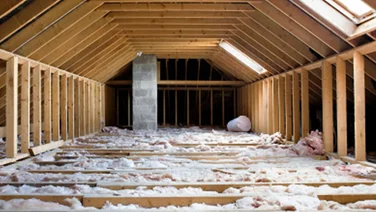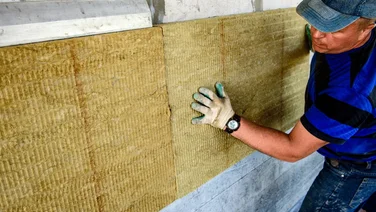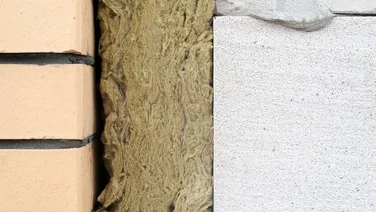- Cavity walls can be filled by simply injecting insulation material into the cavity
- Homeowners can save up to £370 a year by installing cavity wall insulation
- Depending on the costs and savings made, you could be able to make back the installation cost in 11 to 13 years
Keeping our homes warm in the winter is often a priority in the run-up to the chillier months.
One key way that houses can lose valuable heat is through uninsulated cavity walls. After all, what is the point of spending hundreds of pounds heating your home just to have it lost through your walls?
If this interests you, keep reading to find out the importance of cavity wall insulation and find ways to reduce the cost.
If you want to get quotes for cavity wall insulation, simply pop your details into this form and our trusted installers will get back to you.
Get free insulation quotes
Answer a few quick questions, and our trusted installers will send you bespoke insulation quotes – for free.
Compare now
What is cavity wall insulation?
To understand cavity wall insulation and how it works, let’s look at the difference between a solid wall and a cavity wall. A cavity wall is made up of two walls (called leaves) with a gap in between. The outer wall is usually made of brick, and the inner layer is either brick or concrete block. A solid wall, on the other hand, has no interior cavity and can be very thick (if stone) or very thin (if a single leaf of bricks).
Cavity wall insulation is when a heat-retaining material is inserted into the gap between the walls to retain as much heat inside your home as possible. While the air cavity does provide some form of insulation, cavity wall insulation usually works much better.
About a third of the heat lost in an uninsulated home escapes through the walls. Properly insulating cavity walls will save energy and cut your heating bill.
About a third of all the heat lost in an uninsulated home escapes through the walls. By properly insulating cavity walls, you will save energy and cut the cost of your heating bill.
How does cavity wall insulation work?
In most cases, cavity walls can be filled by injecting insulation material from the outside.
The installer will drill small holes, at intervals of around 1 metre, in the outside wall of your home. They then insert insulation into the cavity using special equipment. Once all the insulation material is in, the installer will fill the holes in the brickwork so you’ll barely notice them. Simple!
Filling cavity walls is not a job you can do yourself, so you’ll need to hire a registered installer.

The cost of cavity wall insulation
Cavity wall insulation costs vary depending on the size of your home and which type of insulation you choose. On average, you should be able to make back the installation cost in 11.5 to 13 years – thanks to the savings you’ll make on your energy bills.
These savings are becoming more important as the energy crisis causes bills to rise. The Eco Experts’ National Home Energy Survey made it clear how important this is to people across the UK. According to the survey, 60% of UK residents wanted to go greener to cut down on energy bills. Cavity wall insulation is a great way to do this.
For cavity wall installation in a semi-detached home, you can expect to pay roughly £2,700, whereas for a flat, you’ll be looking at spending around £395 (although if you live in a flat, it’s possible the entire building will need to be insulated). Of course, larger homes will cost more.
You’ll need to make sure the insulation is installed correctly – otherwise, it could end up costing you more in the long run. Check out which problems to look out for on our page The Top 5 Problems with Cavity Wall Insulation.
Below, we’ve outlined the cost of cavity wall insulation for each type of property. To get a more accurate idea of how much it will cost you, simply fill in this quick form, and our suppliers will contact you with a free quote.
Data from Energy Saving Trust
How much can I save by using cavity wall insulation?
Although the initial cost of cavity wall insulation will be a few hundred pounds, you’ll likely make your money back quickly. In fact, installing cavity wall insulation can save homeowners between £100 and £370 a year on energy bills (depending on home size and age).
Take a look at the graph below to compare how much money you can expect to save on your energy bills each year. You’ll also be pleased to know that you’ll be making a huge dent in your carbon footprint by getting your house insulated.
Data from Energy Saving Trust
What types of cavity wall insulation are available?
There are three main types of cavity wall insulation:
- Blown mineral fibre – This option tends to be the most environmentally friendly insulation to go with. Fibreglass flakes have little impact on the environment, and the raw materials used in the production of glass wool can be sourced from recycled glass, sand, and other minerals. The insulation can also be recycled once you need it replaced. Fibreglass insulates very well, and, as a result, households will use much less energy.
- PUR (polyurethane foam, also called spray foam) – PUR tends to be the most effective material for cavity wall insulation, but is also the most expensive, and isn’t particularly eco-friendly as a material. This fluid-like material is injected into the cavity, before expanding and filling all the gaps inside the cavity. As a result, you get seamless insulation without thermal bridges.
- Polystyrene beads or granules – Similar to mineral fibre, these beads or granules are blown into the cavity using compressed air. They may be supplied loose, or in a light sticky resin to hold them together. This type of insulation tends to be cheaper than others, but beware – it isn’t as efficient as PUR, and isn’t as environmentally friendly as glass wool.
Compare different types of materials on our page: The 5 Best Cavity Wall Insulation Options for Your Home.
How can I tell if I have a cavity wall?
One of the main ways to tell if a building has a cavity wall is by its age. If your house was built after the 1920s, it’s likely to have cavity walls.
Another telltale sign of a cavity wall is the brickwork on the house. A cavity wall usually has an even pattern, with all the bricks laid lengthways, whereas a solid wall has an alternating pattern, with some bricks laid across the wall (so you can see the smaller ends from the outside).
You can also tell if the brickwork has been covered by measuring the width of the wall. Examine a window or door on one of your external walls – if a brick wall is more than 260mm thick, then it probably has a cavity.
If your home is less than 20 years old, it is likely to already have cavity wall insulation.
Are there grants for cavity wall insulation?
No matter how much cavity wall insulation can reduce your energy bills, some people simply can’t justify the initial cost.
If this sounds familiar, fear not – there’s still a way for you to benefit from this handy home insulation. The government has two major grants to help homeowners increase their household energy efficiency.
ECO4
This government scheme requires large energy suppliers to support low-income, fuel-poor, and vulnerable households in making energy efficiency improvements to their homes. It can help with a range of improvements, although you may not be able to choose which ones you get.
However, not everyone will be eligible for this scheme. To reap the benefits of ECO, you need to live in an energy-inefficient home (which means a rating of D to G, or E to G in some cases). You need to either be a core group customer from scheme year 9 onwards under the Warm Home Discount Scheme (currently suspended but will restart in October 2024), or you must receive at least one of the following benefits:
- Child benefit
- Pension Guarantee Credit
- Income-related Employment and Support Allowance (ESA)
- Income-based Jobseeker’s Allowance (JSA)
- Income Support
- Tax Credits (Child Tax Credits and Working Tax Credits)
- Universal Credit
- Housing benefit
- Pension Credit Savings Credit
Local authorities are also able to refer residents who they feel would benefit from the scheme (for example, if you are on a low income and someone in the house has a chronic health condition) under ECO Flex.
The scheme isn’t available in Northern Ireland – you can find out more about grants available in Northern Ireland.
Next steps
Once you’ve figured out all the details of cavity wall insulation, you’ll be well on your way to a more efficient and eco-friendly home.
Next, all you have to do is find an installer. We recommend that you take your time to look around for the best deals – and always make sure the installer is registered with one of the following organisations:
- The National Insulation Association (NIA)
- The Cavity Insulation Guarantee Agency (CIGA)
- The British Board of Agrément (BBA)
To receive a free quote for cavity wall insulation, simply pop your details into this quick form.







